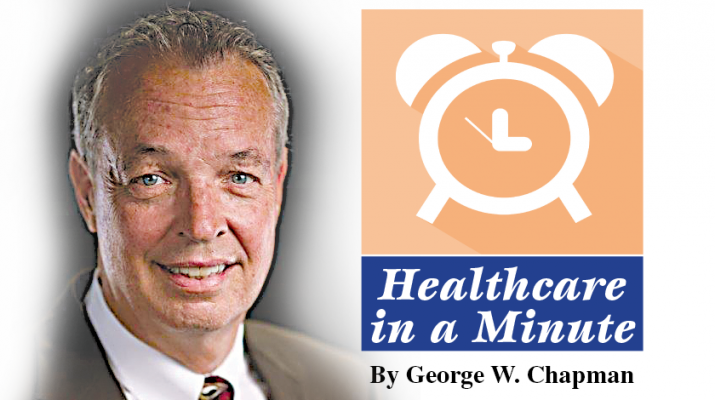By George W. Chapman
Insurance Market Dominance
Critics of the Affordable Care Act have been quick to point out that insurance choices on the exchanges in several markets are limited to only one carrier or at least a dominant carrier. But lack of choice is not limited to the exchanges. The exchanges merely reflect what is going on across the country: commercial insurance is becoming increasingly concentrated in many markets which can be bad for employers, consumers and providers. Carriers have been quick to abandon markets where they have less than a 10 percent market share, leaving even more market share for the already dominant insurer. Physicians are particularly cognizant of the increasing concentration and dominance of certain carriers in their respective markets. According to a survey by the American Medical Association, last year 43 percent of metropolitan markets had a single carrier with over 50 percent market share. It was 40 percent in 2014. Overall, 69 percent of metro markets experienced a “significant absence of health insurer competition” resulting in a “highly concentrated” rating based on federal guidelines used to assess competition. To maintain competition and reduce the risk of monopolies, federal judges have prevented the proposed mergers of Aetna-Humana and Anthem-Cigna. To counter, America’s Health Insurance Plans (AHIP) point out that increased hospital mergers also threaten market competition. The FTC and Department of Justice remain wary of all mergers, purportedly for improved services and cost reductions, that end up increasing prices in a market.
Uninsured Number Goes Up
According to the Gallup-Sharecare Well-Being Index survey, the number of uninsured increased to 12.3 percent in the third quarter of 2017 after an all-time low of 10.9 percent at the end of last year. Considering the uncertainty and confusion caused by Washington, this comes as no surprise considering the cost sharing reduction payments (subsidies) and the individual mandate have been threatened; the enrollment period was cut in half; and outreach and advertising budgets were slashed. Open enrollment for 2018 ends Dec. 15.
Confidence in Congress Low
In a recent poll of its members, the Medical Group Management Association (MGMA) revealed that 89 percent of over 1,500 respondents said they had “low confidence” in their politician’s ability to solve the nation’s healthcare problems. Ten percent expressed moderate confidence, leaving just 1 percent with high confidence. Instability, uncertainty and lack of vision were cited as reasons for low confidence.
Patient Non-compliance Costly
Most physicians rank “patient non-compliance” as a major contributor to poor outcomes. An article that appeared in the New England Journal of Medicine estimated the cost of non-compliance was $100 billion a year….over 10 years ago. Non-compliance is especially high in patients being treated for HIV, high blood pressure, mental health disorders and childhood illnesses. Not taking medications as prescribed is also considered non-compliant behavior leading to poor outcomes. Behavioral economics in medicine has not come up with any easy answers for improving patient compliance. Increasing out-of-pocket payments, high deductibles and copays, could be a contributing factor to patient non-compliance.
Opioid Scam
One hundred forty people a day are dying from opioid overdoses. As if that isn’t bad enough, there are unscrupulous providers trying to enrich themselves at the expense, if not the life, of others. A 74-year-old physician and two of his staff were arrested in NYC for writing thousands of medically unnecessary prescriptions for oxycodone and fentanyl thereby flooding the local community with the highly addictive opioids. The physician charged $200 to $300 cash for a “patient visit” resulting in over $2 million. The “patients” then sold the drugs to a local dealer who then sold the drugs on the streets.
Genetic Testing Closer
It is becoming cheaper and simpler all the time. Right now it costs about $100 on average. Mail order tests like “23andMe” and “Color Genomics” are practically mainstream. Experts think these tests will cost almost nothing in a few years and will be paid for by all insurances. The results of the genetic testing will help physicians to be more targeted or precise when ordering treatment plans for problems like cancer and high risk pregnancies. Patients determined to be at risk for diseases like cancer can be treated preventively which would save payers millions over the long run.
Merger Mania
Not to be outdone by insurance company and hospital mergers, CVS Health (the pharmacy benefits management company, not the drug stores) has offered to buy mega insurance company Aetna for $70 billion. CVS Health would pay for Aetna with cash and stocks. CVS Health figures once they own an insurance company with its 52 million members, it will be able to negotiate lower prices for drugs.
Nurse Shortage
A survey of over 3,300 nurses conducted by a national recruiting firm revealed 36 percent of respondents plan to retire in a year. Other surveys show 73 percent of baby boomer nurses plan to retire in the next three years. The Bureau of Labor Statistics predicts nursing jobs will increase 15 percent from now until 2026. The healthcare industry will be hard pressed to replace all the experience and institutional knowledge that will retire with the baby boomer nurses.
George W. Chapman is a healthcare business consultant who works exclusively with physicians, hospitals and healthcare organizations. He operates GW Chapman Consulting based in Syracuse. Email him at gwc@gwchapmanconsulting.com.

